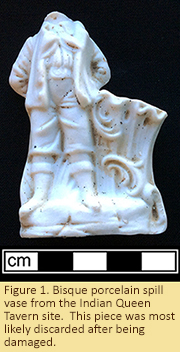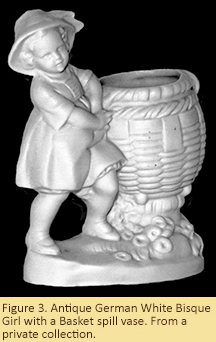Curator's Choice 2018
Spill Vase
January 2018
By Patricia Samford, MAC Lab Director
 This curious little bisque porcelain figure was found during recent archaeological work at the Indian Queen Tavern (18PR96) in Bladensburg. The hollowed stump beside which the young boy is standing was obviously made to hold something, but it seemed much too small for a floral bouquet. And indeed, this little vase was created to hold something quite different from blossoms.
This curious little bisque porcelain figure was found during recent archaeological work at the Indian Queen Tavern (18PR96) in Bladensburg. The hollowed stump beside which the young boy is standing was obviously made to hold something, but it seemed much too small for a floral bouquet. And indeed, this little vase was created to hold something quite different from blossoms.
 In the days before sulphur and phosphorus friction matches became commonly available, lighting tobacco pipes, candles and stoves had to be accomplished using lighted tapers or "spills" to transfer fire from another source. Spills could be
In the days before sulphur and phosphorus friction matches became commonly available, lighting tobacco pipes, candles and stoves had to be accomplished using lighted tapers or "spills" to transfer fire from another source. Spills could be  crafted from a variety of substances, including twisted fragments of paper, reeds, or wood shavings. The term “spill” is a derivative of the word “spile”, in use as early as 1513 to describe a splinter, or narrow strip of wood (OED 1991).
crafted from a variety of substances, including twisted fragments of paper, reeds, or wood shavings. The term “spill” is a derivative of the word “spile”, in use as early as 1513 to describe a splinter, or narrow strip of wood (OED 1991).
Matches were first made in Great Britain in the 1820s by hand dipping small sticks of wood into sulphur. Dipping the sulphur tip into a small container of phosphorus would cause the match to ignite. Friction matches, lit by striking the tip against a rough surface, were invented around the same time in England. Wooden splints or pieces of cardboard were treated with sulphur, sulphide of antimony, chlorate of potash and gum (Crass 1941). Friction matches did not become widely available until much later in the nineteenth century.
It was necessary to store spills, ideally someplace near a fire source, so spill vases were a common feature of Victorian mantels. During the nineteenth century, a number of decorative containers, made from ceramic, glass, brass and even iron, were manufactured to hold spills (Cox 2009). The dropping prices of friction matches in the late nineteenth century led to the demise of this interesting form of material culture.
| References |
|
| Cox, Gary |
| 2009 |
Spill Holder. Antique Answer Man. Website accessed December 8, 2017. http://antiqueanswerman.blogspot.com/2008/11/spill-holder.html. |
|
| Crass, M. F., Jr. |
| 1941 |
A History of the Match Industry. Part 1. Journal of Chemical Education 18(3): 116–120. |
|
| OED |
| 1991 |
Oxford English Dictionary. Oxford University Press, Oxford. |
|